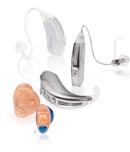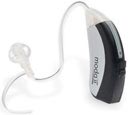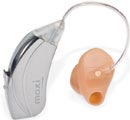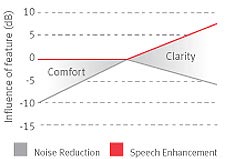Unitron's Next Family of Hearing Instruments: Everything You Need to Succeed
 Paul Dybala: Hello everybody, this is Dr. Paul Dybala with AudiologyOnline. Today I am talking with Bill Christman from Unitron Hearing. Bill, could you start by introducing yourself and telling us about your professional background?
Paul Dybala: Hello everybody, this is Dr. Paul Dybala with AudiologyOnline. Today I am talking with Bill Christman from Unitron Hearing. Bill, could you start by introducing yourself and telling us about your professional background?
Bill Christman: No problem. Thank you for the opportunity. It's always a pleasure to talk with you.
I have been with Unitron Hearing now for nine years. Over the course of the nine years, I have worked in outside sales, technical support, training, research and development, product management and marketing. Most of this time has been spent working here in the US office in Minnesota;however, I also worked for two years at our Operations Centre in Kitchener, Ontario. Dybala: That is great, and today you are going to tell us about Unitron's latest product, Next™. I think your tag line, "Everything you need to succeed," is very appropriate, because there are several different options that come with this product. Could you tell us more about the different technology levels?
Dybala: That is great, and today you are going to tell us about Unitron's latest product, Next™. I think your tag line, "Everything you need to succeed," is very appropriate, because there are several different options that come with this product. Could you tell us more about the different technology levels?
Christman: Definitely. Well, as you mentioned, Next is more than just a single product. It is actually a family of products. There are four members to the Next family. There is the Next 16, Next 8, Next 4, and Next E.
These four products are meant to span a range of the technology levels from the advanced technology category down through the essential - also referred to as entry-level - category. You have four different products there, so you can answer any of the different listening lifestyle or budget needs of your clients.
Dybala: I like the way you label your hearing aids, because the numbers actually represent channels and bands, correct?
Christman: Correct. 16, 8 and 4 refer to the number of channels. Next 16 and Next 8 have 16 channels/16 bands and 8 channels/8 bands, respectively. Next 4 and Next E have 4 channel compression with 8 bands for shaping the frequency response.
Interestingly, I do not think channels and bands are as significant to professionals when evaluating various product offerings as they once were. Clinicians still want to know the information because it gives them a sense of the potential flexibility, but they also concerned with many other aspects of the technology.
Dybala: Absolutely. You also have a split when you start to look at the number of automatic versus manual programs and the type of directionality. Could you explain that for us?
Christman: Sure. The Next 16 and the Next 8 both offer fully automatic functionality for the convenience of "hands-free" listening. The automatic performance is delivered via the AutoPro automatic program. Next 16 features AutoPro3 and Next 8 features AutoPro2. The numbers "3" and "2" refer to the number of destinations within the automatic program. I think of the destinations as 'subprograms' within the automatic program.


Rather than having a single set of parameters the fitter has to use to address all the different listening situations that a person may go into, they can actually program multiple unique settings. Wearers have an automatic program customized for listening in quiet, listening in noise situations where there is also speech present, or listening in noise-only situations. Each destination is independently adjustable by the fitter, providing maximum flexibility to customize the performance of the hearing aid for each of these different situations, without compromising performance in other environments..
The Next 4 and Next Essential have more traditional, manual listening programs, with four and two programs available, respectively. Both of them offer the option of a fixed directional microphone system, whereas the Next 16 and Next 8 have an adaptive directional system in addition to the automatic program.
Dybala: What about style options?
Next style options
Christman: We try to make sure that when we introduce a new product to market that we introduce the full range of shell styles together. Segmenting a product launch by introducing custom versions of a product separately from the BTE versions complicates life for everyone - clinicians as well as employees!
In the Next family of hearing aids, we have everything. Custom product is available in full shell to CIC styles. New with Next, we have also introduced a power CIC as well as a power option for the directional full shell. In BTE styles, we have the standard BTE, power BTE and the high-power BTE. We have the Moxi, which is our very successful canal receiver technology BTE we introduced a year ago. We also have the Moda II, which is our option for slim tube open fittings.
Unitron Moda II BTE
The new form factor that was introduced with the Next is the OptimumFit. It is a new custom option that can be used with Moxi. It is a custom-made option for the patient's ear where the receiver is suspended within the shell itself.
I think one of the most attractive things about this option is the ability to adjust the wire length on the patient's ear. Rather than having to choose from a predetermined set of wire lengths, fitters can actually adjust the length of the wire once it is on the person's ear.
Dybala: How does that work?
Christman: There is a spot on the faceplate of the OptimumFit that can be adjusted to loosen where the wire inserts into the shell. This allows clinicians to place the unit on the client's ear, then lengthen or shorten the tube for a truly customized fit to the individual. Instead of having to choose a size number 0, 1, 2, or 3 and being limited to that;you can actually adjust the length of the wire once you have it on the client's ears.
We still recommend that clinicians measure the patient's ears in order to know whether the fitting would tend towards a longer or shorter receiver wire. This is because we build the OptimumFit with one of two different wire lengths. There is a fair bit of overlap in length between the two, so as long as we know whether the fitting would be with a longer or shorter receiver wire, we can provide the maximum possible fitting flexibility.
Dybala: Do you typically fit the patient with a standard dome until the custom shell is ready?
Unitron Moxi with OptimumFit
Christman: Well, it seems to be approached differently by different customers. Some clinicians do what you described to be able to provide a same-day instant fit. The patient comes in and they have the ability to let them leave that day with the hearing aids. Then, they switch them out to the OptimumFit at the first follow-up appointment. Other clinicians do not deliver the product until they have the custom piece for the patient's ears, which is more similar to the fitting model of a traditional custom product. Either way works, it's usually a matter of how the clinician prefers to approach the fittings.
Dybala: What are the advantages of the custom shell? Does it provide an expanded fitting range?
Christman: I think there are a couple of notable advantages. For some people it provides a more secure feel. They do not have to worry about something working out of their ear as sometimes happens with the various instant-fit coupling options. The custom shell option also expands the fitting range, by increasing the maximum potential gain that can be achieved in the patient's ears. Using a custom shell will typically offer a greater fitting range compared to a dome just by providing a better acoustic seal in the ear canal. But this is not the only reason. It is also related to the way the OptimumFit is built. It has greater mechanical stability than other custom options that have been available for canal receiver technology;therefore, greater amounts of gain can be achieved.
Dybala: Great. Is this more gain before feedback or more gain in general?
Christman: It is more gain before feedback in the fitting - the usable gain a client can actually benefit from in a fitting.
Dybala: I have one more question before we close up the interview today. What is Unitron's philosophy on how to decide which type of technology goes into which hearing aid?
Christman: Unitron always tries to make sure that we are providing technology that we know makes a difference for people. We refer to this as "purpose driven innovation." This is technology that has clear demonstrable benefits for the individual, things like AntiShock, which we introduced originally in the Element family about a year ago.
AntiShock helps provide a clearly demonstrable benefit for keeping a user from being bothered by some of those sharp transient sounds, such as knives dropping, plates clattering, and things of that nature.
Another technology that we introduced with Yuu - our premium hearing aid line - is the Comfort-Clarity balance. For the first time, this feature allows the patient to adjust some of the adaptive features in the hearing aid. Rather than just having a volume control, patients can actually adjust the aggressiveness of the noise reduction and speech enhancement. This has been well received in Yuu;therefore, we felt it was important to make it available in the advanced category in the Next 16.
Comfort-Clarity Balance
Dybala: Well, thank you again for taking time to meet with us today. I do want to direct everybody, if you want more information about Unitron, the Next family, or Yuu, to visit www.unitronhearing.us. You can also visit the Unitron Hearing web channel at AudiologyOnline at /channels/unitron_hearing.asp
for all the latest information from Unitron.
Christman: Thanks Paul - it was nice talking to you again!
More About Unitron Hearing
Unitron Hearing Worldwide branches over more than 70 countries, and through this, Unitron Hearing U.S. works hard to make Unitron an important name in the hearing industry in America. Unitron consistently introduces new advances in product features to better the best in terms of technology, style, and comfort. Unitron provides a full range of products from entry level to premier, all of which provide amazing sound quality for patients of all needs.


